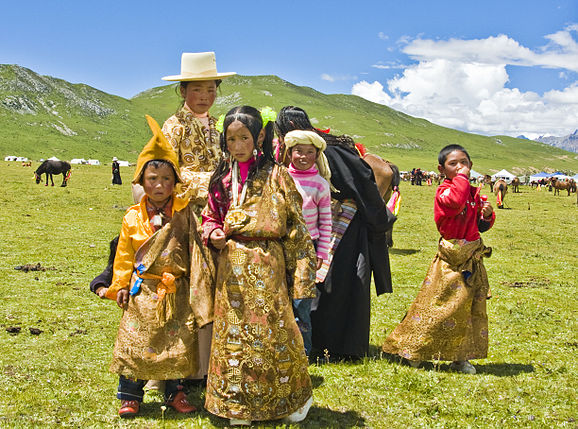Tibetans tend to be conservative in their dress, and though some have taken to wearing Western clothes, traditional styles still abound. Women wear dark-colored wrap dresses over a blouse, and a colorfully striped, woven wool apron, called pangden signals that she is married. Men and women both wear long sleeves even in summer months.
In his 1955 book, Tibetan Marches, André Migot describes Tibetan clothing as follows:Tibetan woman’s dress, Field Museum of Natural HistoryTibetan herdsman’s coat, fur-lined. A portable shrine for worship was carried with a shoulder strap. Field Museum of Natural History
Except for the lamas and for certain laymen who shave their heads, the Tibetans wear their hair either long or in a braid wound around their heads and embellished with a complicated pattern of lesser braids which make the whole thing look like some sort of crown. They often wear a huge conical felt hat, whose shape varies according to the district they come from; sometimes its peak supports a kind of mortarboard from which dangles a thick woolen fringe. In order to prevent their hats being blown away, they attach them to their heads with the long braid I have just described, and which has to be unwound for the purpose. In their left ear they wear a heavy silver ring decorated with a huge ornament of either coral or turquoise. Their costume is not elaborate. It normally consists only of a chuba, a long capacious robe with wide, elongated sleeves which hang almost to the ground. This is caught up at the waist by a woolen girdle, so that its skirts reach only to the knees and its upper folds form an enormous circular pocket round its wearer’s chest. This is called the ampa, and in it are stowed a wide range of implements — an eating bowl, a bag of tsampa, and many other small necessities. Many chubas are made of wool, either the plain gray wool they spin in Sikang or the splendid, warm, soft stuff from Lhasa, dyed a rich dark red. The nomads, on the other hand, generally wear a sheepskin chuba, hand-sewn and crudely tanned in butter, with the fleece on the inside. The town-dwelling Tibetans, prosperous merchants for the most part, supplement this garment with cotton or woolen drawers and a cotton or silk undershirt with long sleeves, but the nomads normally wear nothing at all underneath it, though in winter they sometimes put on sheepskin drawers. The Tibetans hardly ever do their chubas up over their chests. The right shoulder and arm are almost always left free, and when they are on the march or at work the whole top part of the robe is allowed to slip down so that it is supported only by the belt. This leaves them naked above the waist and clad in a very odd-looking sort of skirt below it. They hardly feel the cold at all and in the depth of winter, heedless of frost or snow or wind, they trudge imperturbably along with their bosoms bared to the icy blast. Their feet, too, are bare inside their great high boots. These have soft soles of raw, untanned leather; the loose-fitting leg of the boot, which may be red or black or green, has a sort of woolen garter around the top of it which is fastened to the leg above the knee with another, very brightly colored strip of woolen material.— André Migot (1953), Tibetan Marches







